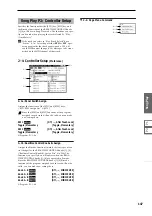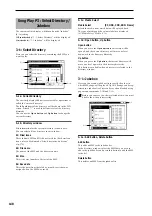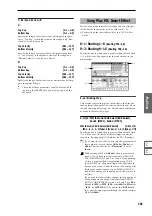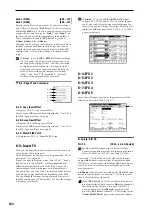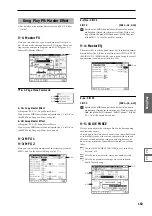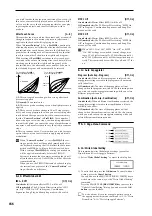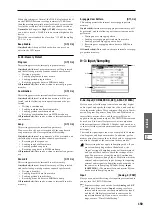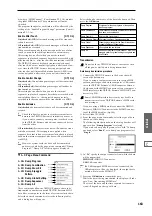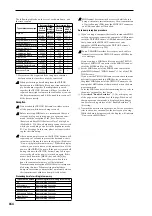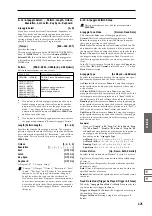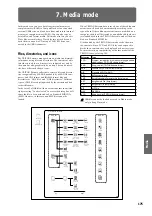
160
Analog:
The analog audio output from an instrument or
other device connected to the AUDIO INPUT 1 and 2 jacks
will be input to the TRITON Extreme.
S/P DIF:
The digital audio output from an instrument or
DAT etc. connected to the S/P DIF jack will be input to the
TRITON Extreme. Use Input1 (below) to make settings for
the L channel of the S/P DIF IN jack, and Input2 for the R
channel. The S/P DIF input/output sample rate is 48 kHz.
If you’ve selected S/P DIF, set “System Clock” (Global
P0: 0–2a) to S/P DIF.
Input1:
Input2:
Level
[0...127]
Specifies the level of the external audio signal being input
(specified by “Input”). Normally you will set this to 127.
The analog audio signal from the AUDIO INPUT 1,2
jacks is converted into a digital signal by an AD con-
verter. This “Level” setting sets the level of the signal
immediately after it is converted into a digital signal. If
the signal is still distorted even after you’ve drastically
lowered this level, it is possible that distortion is occur-
ring before the AD converter. Check the [LEVEL] knob
or the output level of your external audio source.
Pan
[L000...C064...R127]
Sets the pan of the external audio signal being input (speci-
fied by “Input”). If you are inputting a stereo audio source,
you will normally set Input1 to L000, and Input2 to R127 (or
Input1 to R127 and Input2 to L000). If you are inputting a
monaural audio source, you will normally set this to C064.
BUS (IFX/Indiv.) Select
[L/R, IFX1…5, 1, 2, 3(Tube), 4(Tube), 1/2, 3/4(Tube), Off]
Specifies the bus to which the external audio signal being
input (specified by “Input”) will be sent.
L/R:
Sends the external audio input signal to the L/R bus.
IFX1...5:
Sends the external audio input signal to the IFX1–5
bus. Choose this if you want to apply an insert effect.
1, 2, 3(Tube), 4(Tube), 1/2, 3/4(Tube):
Sends the external
audio input signal to the 1–4 bus(es).
Off:
The external audio signal will not be input.
If you want to apply Valve Force to the external audio
signal, choose 3/4(Tube), 3(Tube), or 4(Tube). Set the
Valve Force “Placement” to Insert.
Send1 (to MFX1), Send2 (to MFX2)
[000...127]
In the same as for the oscillator(s) of a program, this param-
eter specifies the level that is sent from the external audio
signal being input (specified by “Input”) to the master
effects. If “BUS (IFX) Select” has been set to IFX1–5, the
send level to the master effects is specified by “Send1” and
“Send2” (Program 8–1d. Combination, Sequencer, Song Play
8–1b) after the signal has passed through IFX1–5. (“2–4.
Audio Input, S/P DIF IN”
If “BUS (IFX/Indiv.) Select” is set to other than Off,
and you raise the “Level” setting, the external audio
source will be input to the TRITON Extreme. At this
time if audio cables are connected to the AUDIO
INPUT 1 or 2 jacks, the noise component will be input
via the AD converters into the TRITON Extreme even if
there is no audio input, and depending on the settings,
may be output from the AUDIO OUTPUT L/R, 1, 2, 3
and 4 jacks. If you want to perform using only internal
sounds such as programs, combinations, and songs,
and are not using external audio inputs, you should set
“BUS (IFX/Indiv.) Select” to Off, or set “Level” to 0.
Similarly, if you are not using the S/P DIF jack, you
should turn “BUS (IFX/Indiv.) Select” Off, or set
“Level” to 0.
If audio cables are not connected to the AUDIO INPUT
1 and 2 jacks, the input to the TRITON Extreme via the
AD converter is forced to zero, and no noise component
will be output.
0–3b: Sampling
Auto Optimize RAM
[Off, On]
If RAM is specified as the data writing destination for sam-
pling, this parameter specifies whether the sample memory
(RAM) will be optimized after data is written.
Optimization rearranges any unused memory areas so that
all of the remaining memory can be used.
On (checked):
RAM will automatically be optimized when
sampling ends.
With this setting, you will always be able to sample without
wasting RAM, but the sound will stop when sampling ends.
If a song was playing in Sequencer mode, the playback will
stop.
Off (unchecked):
RAM will not be optimized when sam-
pling ends. Since the sound will not stop when sampling
ends, this setting is convenient when you want to consecu-
tively sample several sections while a song plays or while
listening to an input source such as a CD.
If “Auto Optimize RAM” is turned Off (unchecked) and
unused areas have accumulated in memory, you can execute
the page menu command “Optimize RAM” (Program P0:
0–3B, Combination P0: 0–3B, Sequencer P0: 0–3B, Sampling)
to optimize the RAM.
The remaining amount of sample memory (RAM) can
be checked in Sampling Mode P0: Memory Status.
Summary of Contents for TRITON Extreme
Page 1: ...2 E ...
Page 11: ...xii ...
Page 111: ...100 9 5 Page Menu Command 0 1A 0 1I 0 1J Program 9 5A ...
Page 185: ...174 ...
Page 215: ...204 ...
Page 281: ...270 ...
Page 349: ...338 ...
Page 350: ...339 ...
Page 351: ...340 ...
Page 352: ...341 ...
Page 353: ...342 ...


